12 kitchen ceiling lighting ideas designed to flatter any space
Your choice of kitchen ceiling lighting ideas can make or break your design. Here’s how the experts approach overhead lighting for all kinds of kitchens


Out of all the lighting decisions you'll need to make for a new kitchen, your kitchen ceiling lighting ideas will be the big hitters for effectively illuminating your space. After all, ceiling lighting encompasses everything from feature pendant lighting to the nuts-and-bolts, functional lighting that creates your kitchen's ambient and task lighting.
There are different requirements for kitchen lighting ideas to other rooms in your home, and the weight of these practical considerations largely falls on getting your ceiling lighting right.
'Kitchens require a lot of unobstructed task lighting, such as spotlights or strip lights,' says architect Ester Corti of Mitchell + Corti, 'whereas feature pendants, although arguably more decorative and beautiful, are more appropriate for islands or dining areas.'
This balancing act between the pretty and the practical is where a kitchen lighting scheme can truly succeed or fail, so consider these 12 kitchen ceiling lighting ideas during your project's design phase to make sure you straddle the divide perfectly.
Kitchen ceiling lighting ideas – how to choose the right designs
Your kitchen's overhead lighting also needs to be considered in relation to the overall lighting mix in the space, including any light sources from kitchen cabinetry and wall sconces.
Layering different lighting treatments is the key to having an adaptable space that can be used flexibly throughout the day to meet the different demands of a modern kitchen, from having a bright space to prep food to posing as a serene backdrop for an open plan living space. Your ceiling lighting really will play different roles in your kitchen at different times of the day.
With that in mind, you should also start out by considering your kitchen's natural light, and its limitations, so that ceiling lighting is considered for daytime kitchen use too, says New York-based interior designer Ahmad AbouZanat of Project AZ. 'To create an effective lighting scheme, you need to understand the natural light that comes into the space at different times of the day. This way, you can assess if there’s a need for artificial light during the daytime too.'
The Livingetc newsletters are your inside source for what’s shaping interiors now - and what’s next. Discover trend forecasts, smart style ideas, and curated shopping inspiration that brings design to life. Subscribe today and stay ahead of the curve.
1. Choose the right lighting for vaulted kitchen ceilings
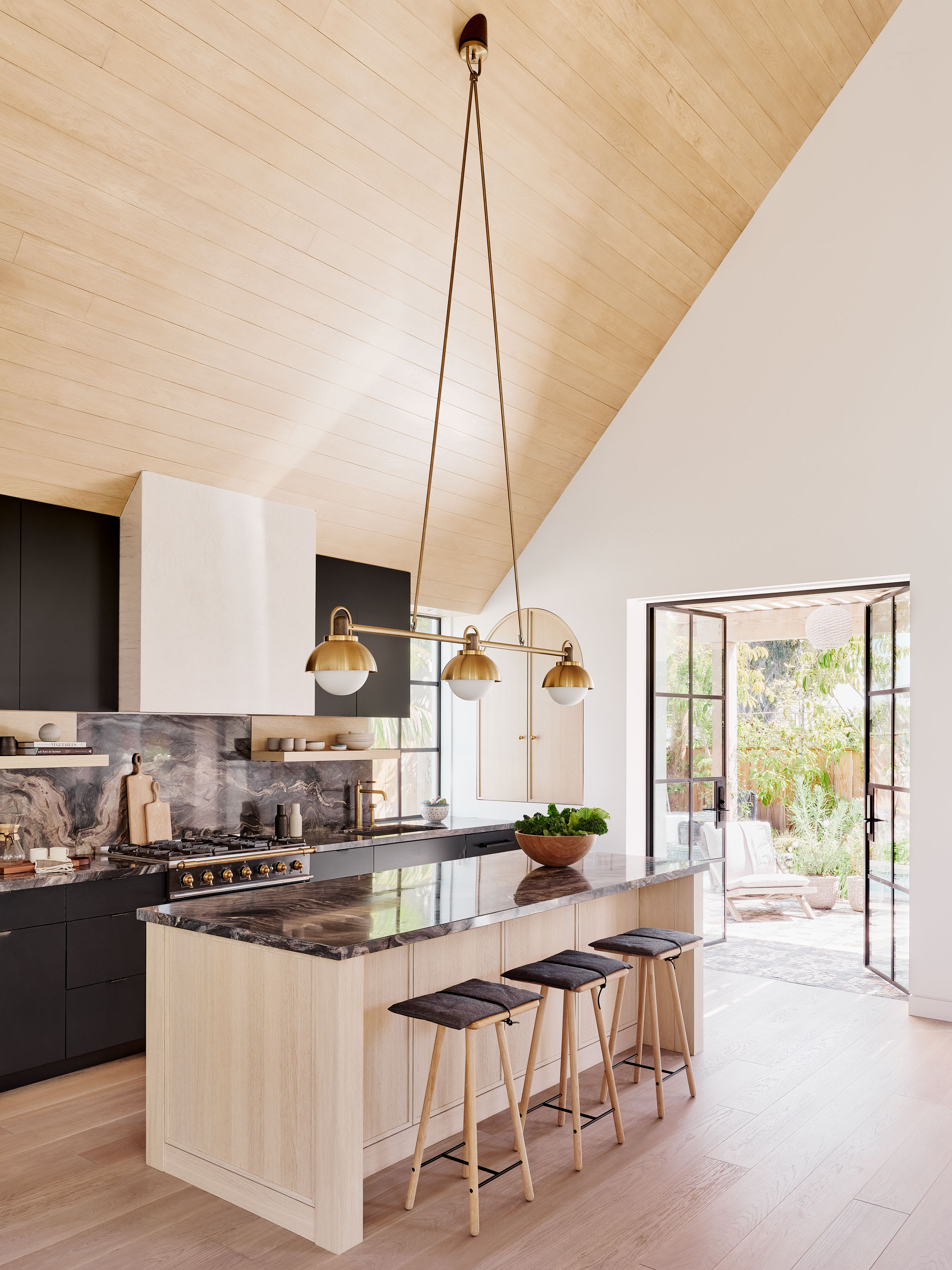
Kitchens with vaulted ceilings, whether they be pitched or just double-height spaces, deserve a lighting design that flatters and accentuates this feature. Traditional kitchen ceiling lighting ideas may need to be adapted to work for vaulted ceilings, and there may be a greater reliance on low-level lighting for these spaces.
This kitchen idea by LA-based architecture studio Laney LA offers so insight into an alternative approach for lighting vaulted ceilings. 'In the HT Residence, we avoided placing recessed lighting in the vaulted ceiling,' explains founding partner Anthony Laney. 'Our intention was to create an uninterrupted moment of calm. The soaring wood ceiling stands in contrast to the activity in the great room below. A suspended light, from Allied Maker, is all that punctuates the space above the kitchen island.'
Uplighting a feature roof, especially one with lofty proportions, is another tactic to try that ensures its character can be appreciated during darker hours too. 'On other projects, we will carefully uplight the vaulted ceiling, allowing the light to reflect back down on the spaces below,' says Anthony.
2. Use LED lighting to create a feature ceiling
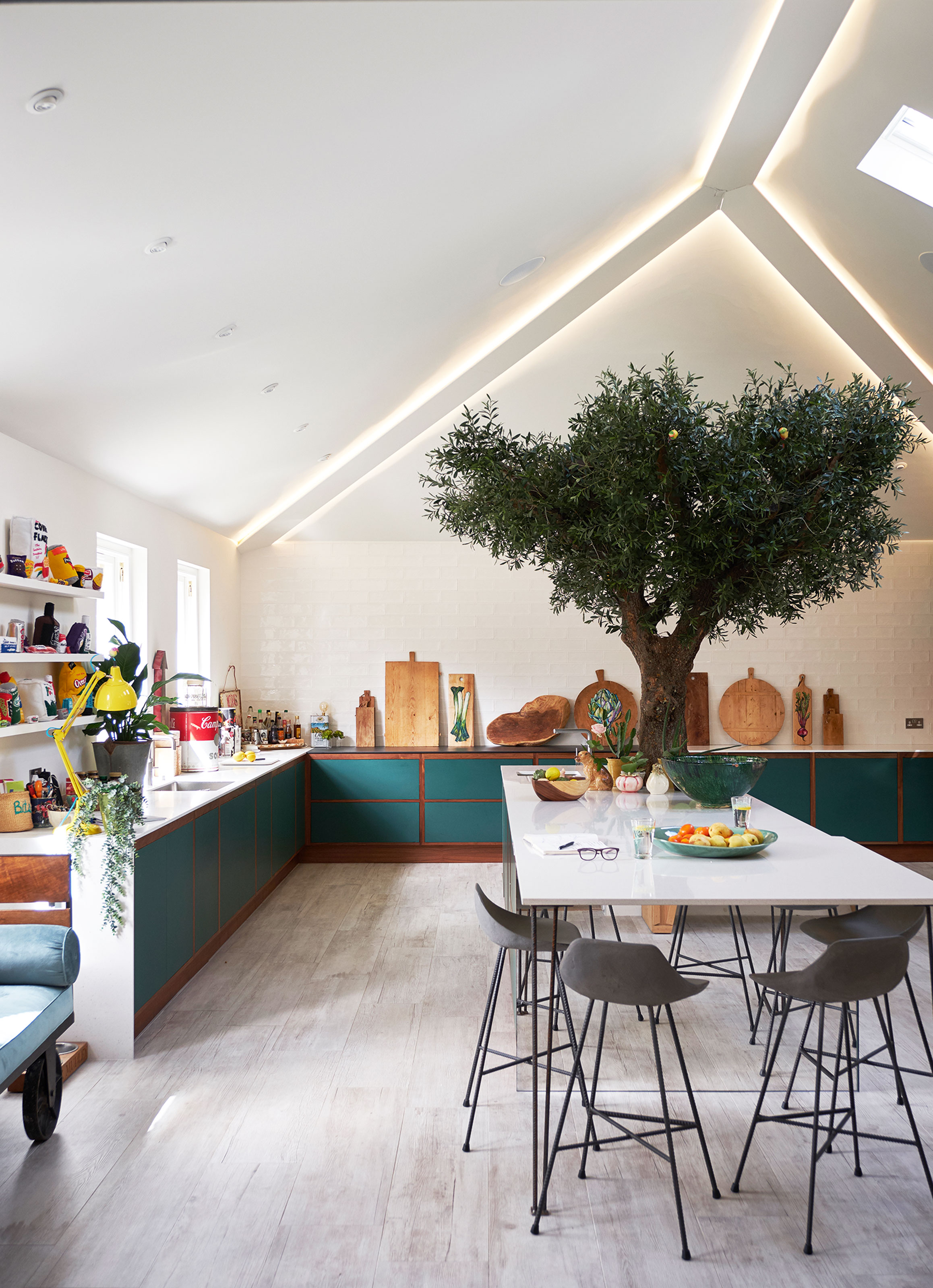
LED strip lighting is one of the biggest lighting trends for kitchens right now, offering a way to bring extra levels to a lighting scheme without cluttering your space with extraneous fittings.
The beauty of this kind of lighting is in its versatility too. 'LED lighting can be used as a form of task-lighting and can also be used to create an ambient atmosphere,' says Sofia Bune Strandh, CEO of Sola Kitchens.
Its applications as a design feature are what makes it a particularly exciting option for kitchen ceilings too. 'In this kitchen, the use of LED lighting successfully emphasizes the high of the ceiling ensuring the olive tree stands out,' says Sofia.
While this ceiling lighting design is very site specific, there are plenty of other ways to use this style of recessed kitchen lighting overhead to good effect. From simple strips creating illuminated graphic lines across the ceiling to tray ceilings with strip lighting integrated around the edges, each style offers the benefit of an even, diffused glow throughout your kitchen.
3. Carefully specify directional and recessed downlights
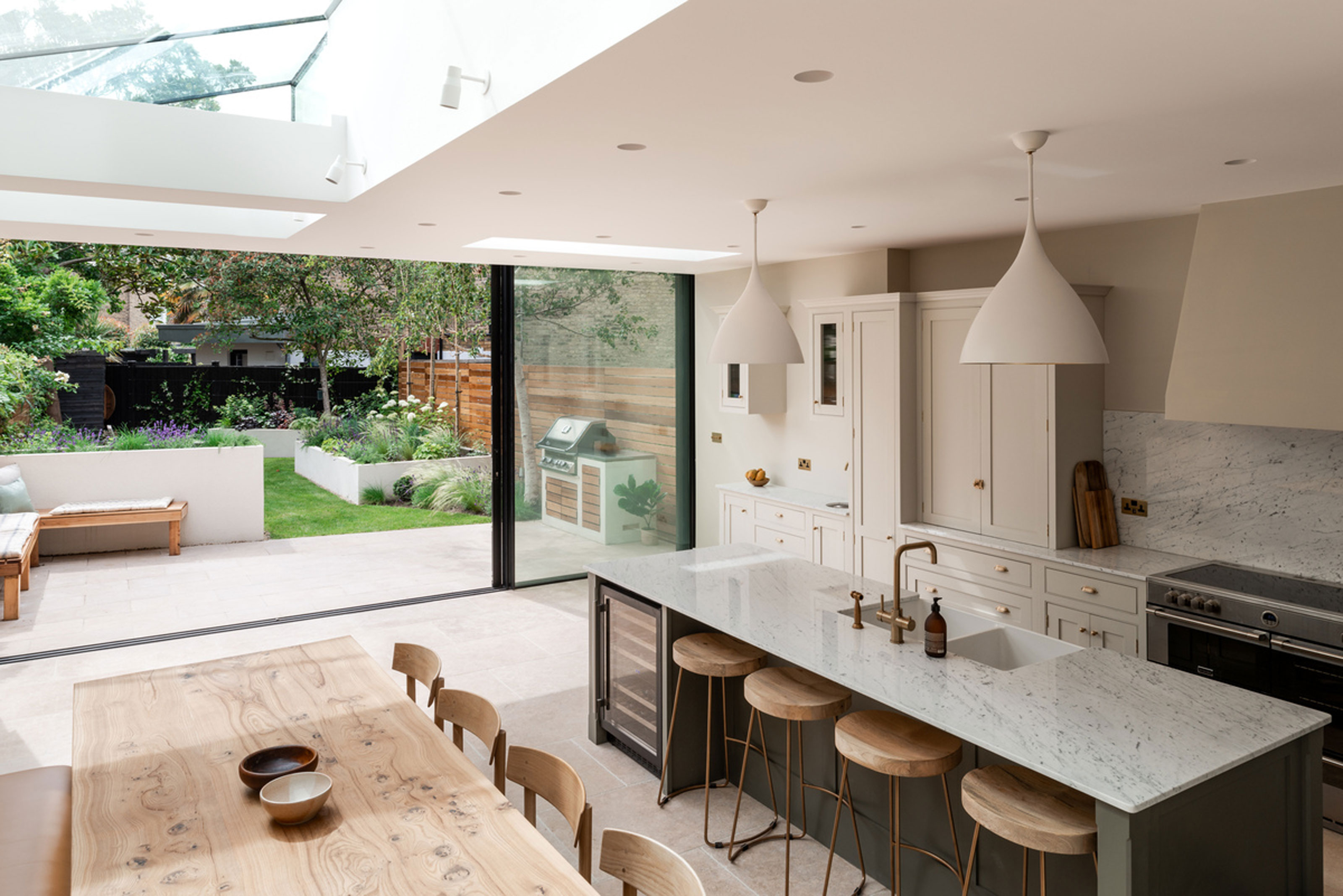
When specifying downlights for a kitchen, the devil is in the detail. Not all downlights are created equal, and your choice of style will not only affect how they look in your kitchen, but potentially impact the light they offer the space.
Let's begin with plaster-over, trimless downlights, as used in this modern kitchen idea created by NOTO Architects. These have become the go-to for many homeowners looking for a sleeker finish to their kitchen ceiling, where traditional downlights can cause visual clutter when used in abundance. However, the nature of the plastered-over style means that the downlighter itself is recessed into the ceiling to some degree.
This can limit the spread of the beam from downlights, creating a narrower, more focused light. For an even ambient light across your room, this may mean more lights are required closer together, so making a decision on the type of downlighter you're using is important at an early stage of your build.
You should also consider where, or whether at all, you're incorporating directional downlights. Most styles of directional downlighter are adjustable, meaning that you have some flexibility in your design when using these over fixed downlights, but are likely to come at an extra cost. Considering where directional light may work well, such as to add task lighting or for accent lighting on walls or kitchen cabinets, for example, can help you plan when and where directional lights are appropriate.
4. Consider how glazed roof lights will affect your lighting scheme

For modern kitchen extensions with skylights or roof lanterns, some thought needs to be given to the relationship between these glazed elements and your kitchen ceiling lighting ideas.
'Addressing lighting around skylights can be tricky,' says architect Ester Corti of Mitchell + Corti. 'The choices all narrow down to the overall aesthetic one is after and the specific use of the areas below/around the skylight.'
'We always try to avoid locating a skylight over a kitchen counter or island, opting for placing it between counter space, in order to allow for pendant lights over islands and either pin lights, plastered over trimless spotlights, concealed LED strips with diffusers and/or wall lights in the kitchen area.'
Directional, ceiling-mounted lighting can help fill gaps in your scheme created by overhead glazing, but where your kitchen design dictates a need for lighting in glazed portions, there are design solutions you can try. Some roof lantern styles can incorporate casings for electrical wires, making it possible to hang a pendant light from the center of the lantern, while using exposed rafters along a glazed side return extension gives you the benefit of natural light overhead during the day, with something to hang pendant lights from or fix spotlights to.
5. Dedicate ceiling lights to task areas

Positioning downlights and spotlights in a kitchen lighting scheme should be informed by their use as task lighting.
'Decorative pendants are very popular as kitchen island lighting ideas as people want to make a statement and feature, but it’s important to be careful not to create shadows over the cooking and prep area,' says Piero De Marchis, director of Detail Lighting.
'To make sure this doesn’t happen, we would normally advocate decorative lighting ‘filled-in’ and supplemented with focused spotlights to eliminate any dark spots. By opting for this combination, you will then have a ‘cooking mode’ where all the lights are on and then a more relaxed mode when you can turn off the spotlights and dim your decorative lights.'
'Try to reduce shadows on task areas,' Piero also suggests, 'so when leaning over the work-top the lights should not be directly behind you.'
This level of lighting application requires you to reflect on how a kitchen space will be used – a challenge for a new space that exists only as a concept – which might require a detailed conversation with your kitchen designer or a leap of imagination on your part.
6. Pick the right pendant lighting

Kitchen pendant lighting ideas come in all shapes and sizes, so where do you begin in starting to narrow down your choices?
'The shape and number of pendant lights is always relative to the scale of the space we’re working in and to the functionality,' says interior designer Ahmad AbouZanat, 'meaning the design of the kitchen dictates what type of fixture to use.'
'Transparent fixtures, such as glass globes or wired drums are great for small kitchen lighting ideas, while linear and minimalist designs are good for a sleek look if the light has an interesting backdrop,' he continues. 'Heavier or larger fixtures (such as drums) might be the right choice if the space is larger, or there’s an opportunity to see them from different perspective – in other words, they’re there but not necessarily obstructing a view of or from the space.'
7. Use ceiling lighting to zone your kitchen

Ceiling lights have an important role to play in open plan kitchen ideas, helping to demarcate different areas of your space visually and create a sense of order and flow for the eye from the top of the room down.
Pendant lighting is a particularly useful tool for this as it can ground furniture such as dining tables and kitchen islands, and makes a new center for a zoned area in a larger open-plan space.
Downlights can also be used on circuits that are independently operated. At night particularly, this allows you to zone areas by the main ambient lighting of your kitchen, drawing in a large open plan room and making it feel more intimate and cozy by only partially illuminating it.
8. Try this lighting idea for ceilings with exposed rafters

As a popular interior design trend, exposed rafters see plenty of action in contemporary kitchens, adding an interesting architectural element to what can otherwise be a bland part of your room's design.
As this style of ceiling is usually created using a property's structural elements, rather than being added in as a decorative afterthought, the lighting layout is pretty easy to achieve, and these rafters can act as a grid to ensure you have a good, even spread of lights across the whole of your kitchen. However, much like using recessed downlights, the rafters themselves can get in the way of light from flush downlights, potentially causing shadowy areas across your scheme.
The most popular solution to this issue is to use surface-mounted spotlights with rafters. These semi-flush lights act like protruding downlights, ensuring your lighting clears the rafters and offers better illumination to your kitchen.
9. Explore ceiling-mounted lighting designs
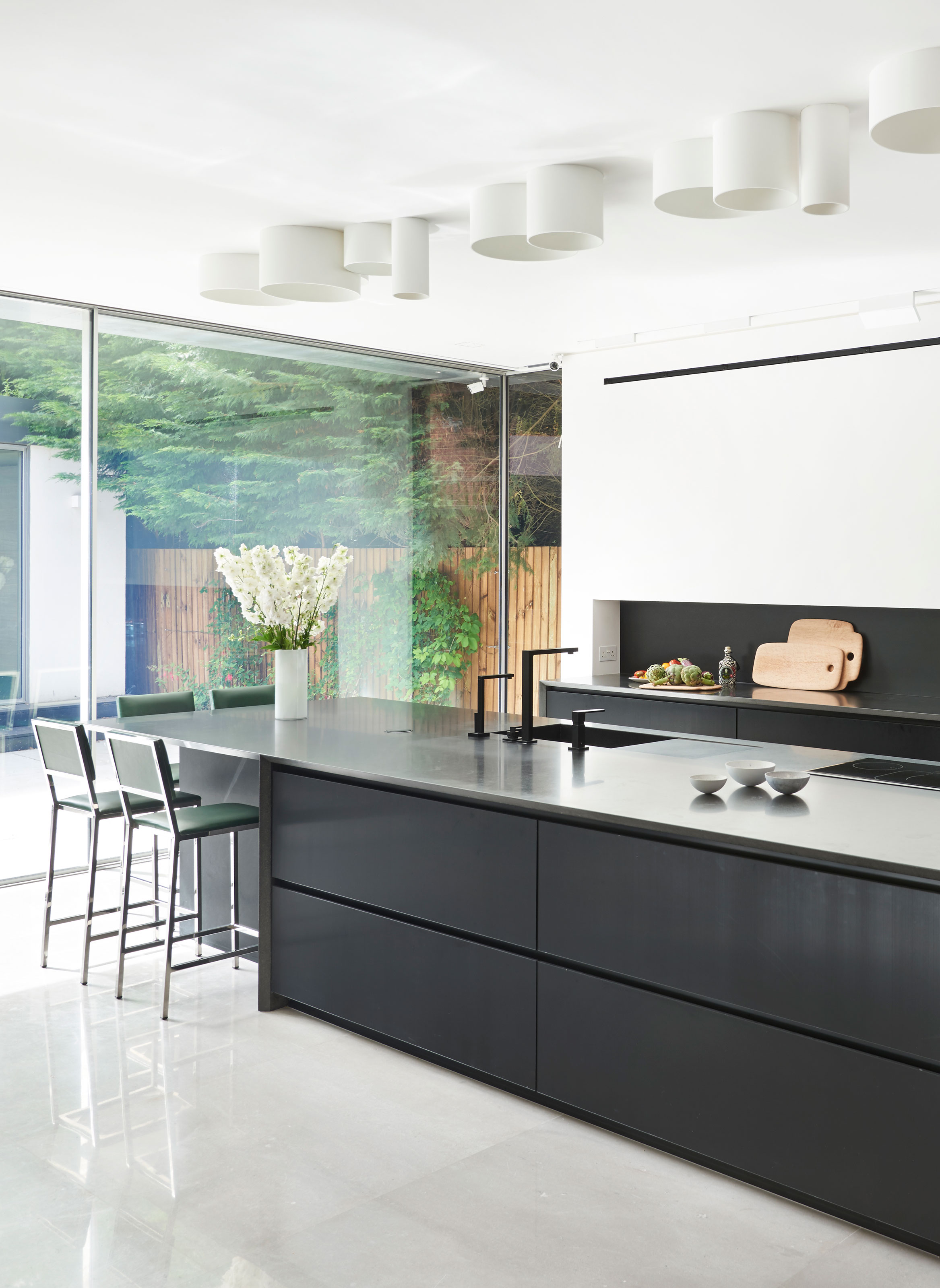
Flush, semi-flush and other ceiling-mounted fixtures shouldn't be an afterthought for your kitchen ceiling lighting ideas. They can offer a design-forward style that also skirts some of the drawbacks of pendant lighting in a kitchen, especially over a kitchen island where dropped fixtures can interrupt sightlines or you have multiple pendant lights fighting for attention in an open-plan space.
The sculptural flush lighting installation was commissioned by the homeowner as part of a kitchen renovation project undertaken by Designspace London, and is complemented in the wider space by a linear pendant used an minimalist dining room lighting idea.
10. Choose track lights for an adaptable kitchen lighting

The benefits of track lights are often overlooked for contemporary kitchens. 'They can often be adjusted and rotated, so give a good amount of flexibility,' says architect Ester Corti, 'but they are visually more dominant therefore do not always fit the overall aesthetic.'
Of course, there are modern track light styles that would be at home in any luxury kitchen, and in a design such as this sleek handleless kitchen in a London property, the rig-like lighting set-up becomes a point of interest for the room.
11. Install your ceiling lighting on circuits

Choosing the right kitchen ceiling lighting ideas alone doesn't guarantee a lighting scheme that functions well. How they're installed will also affect how your lighting can be controlled, playing into the range of moods you're able to create in the room.
'Consider how circuits are used in your design,' says Detail Lighting's Piero De Marchis. 'Luxury, perimeter lighting should be separated from the center — have the island or a dining table on its own circuit to change the mood.'
In a larger kitchen, you may want (or even need) more circuits for a greater number of downlights used through the space, helping to control the lighting in zones. However, the key to getting circuits right when it comes to your kitchen lighting is in balancing this ratio of circuits to lights.
A three or four toggle switch is the ideal quantity, offering you suitable control over your lighting without it becoming difficult to get to grips with which switch turns on which light.
12. Use dimmers for ceiling lighting where appropriate
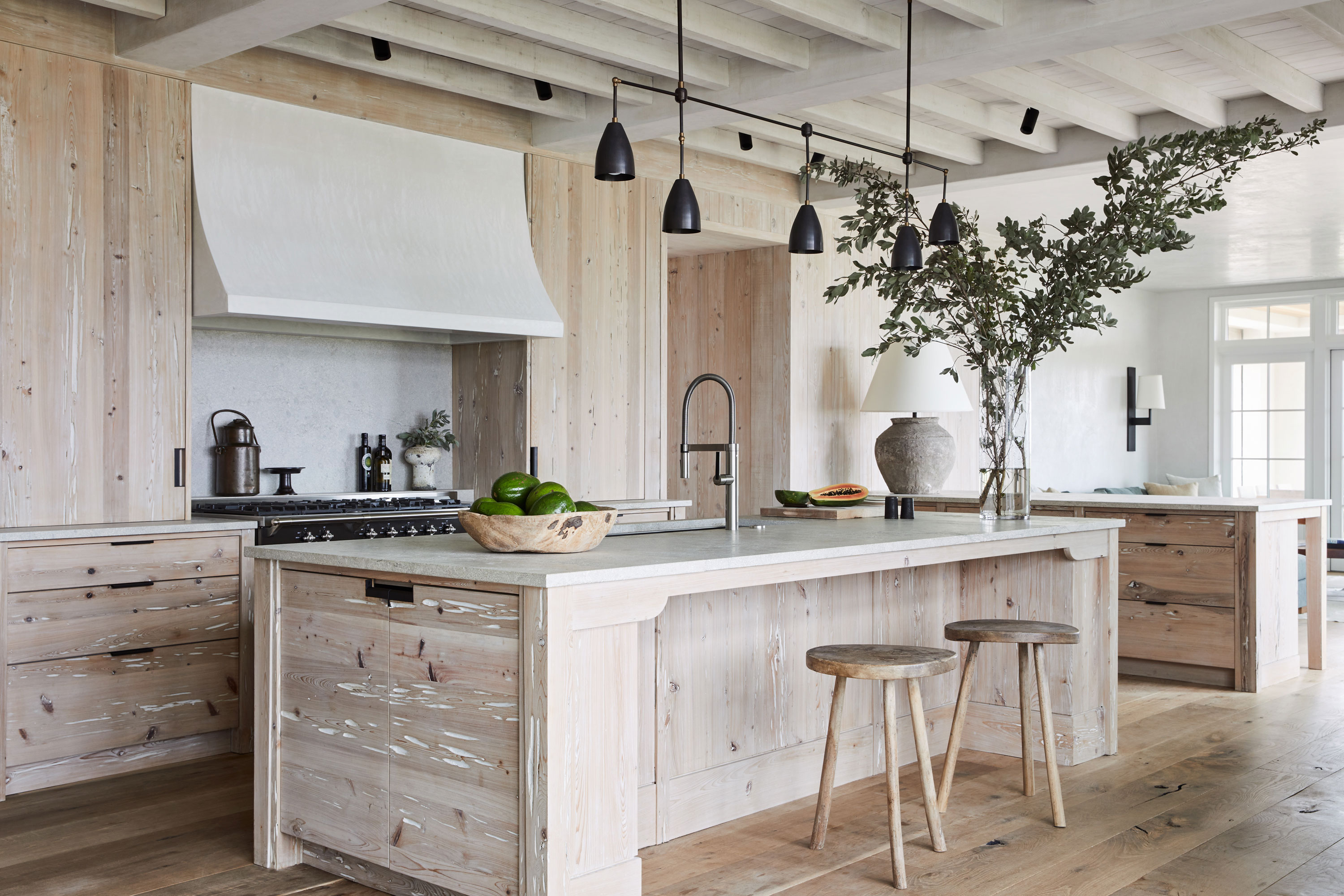
'Dimmers aren’t necessarily as popular in kitchens as living spaces,' says Ahmad AbouZanat of Project AZ, 'but it might be something you want to consider for your ambient lighting if the kitchen is open-plan.'
Adding a dimmer can help your kitchen ceiling lighting ideas transition between task and ambient lighting as required, something that's particularly useful for later evenings when the kitchen may not be in use aside from as a backdrop for the rest of your space.
You'll need to check your LED lighting is compatible with the dimmer you’re using. Not all LED lighting works with a dimmer and in some cases using a dimmer with a wrongly-specified light could even damage your circuits. Be sure to choose a dimmer that has a wattage high enough to handle the number and wattage of your bulbs.
What light color temperature is best for kitchen ceiling lighting?
Striking a balance between practical and good-looking lighting causes one dilemma when it comes to kitchen ceiling lighting — choosing the right light color temperature. Measured in Kelvins (K), cool light is better for task lighting, warm light is more relaxing to the eye, while also promoting better sleep.
'Think of using 3000K in a utility area where a whiter light will make the space feel fresher,' suggests lighting designer Estefania Marquez of John Cullen Lighting. 'However, for most rooms within the home, 2700K is our preferred color temperature.'
Combining different light temperatures across a space can look jarring so is best avoided, but using a smart LED automated lighting system may offer you the option to shift color throughout the day to suit the task at hand, controlled by a remote or an app.
How bright should kitchen ceiling lighting be?
Brightness is another factor that needs to be considered for your kitchen ceiling lighting – usually, kitchens should be double the brightness of a living room.
'Kitchen lighting needs to be adequate for task-related matters such as cooking and cutting,' says Detail Lighting's Piero di Marchis. 'About 800 lumens is a good starting point and if it’s dimmable then that’s a bonus.'

Hugh is Livingetc.com’s editor. With 8 years in the interiors industry under his belt, he has the nose for what people want to know about re-decorating their homes. He prides himself as an expert trend forecaster, visiting design fairs, showrooms and keeping an eye out for emerging designers to hone his eye. He joined Livingetc back in 2022 as a content editor, as a long-time reader of the print magazine, before becoming its online editor. Hugh has previously spent time as an editor for a kitchen and bathroom magazine, and has written for “hands-on” home brands such as Homebuilding & Renovating and Grand Designs magazine, so his knowledge of what it takes to create a home goes beyond the surface, too. Though not a trained interior designer, Hugh has cut his design teeth by managing several major interior design projects to date, each for private clients. He's also a keen DIYer — he's done everything from laying his own patio and building an integrated cooker hood from scratch, to undertaking plenty of creative IKEA hacks to help achieve the luxurious look he loves in design, when his budget doesn't always stretch that far.